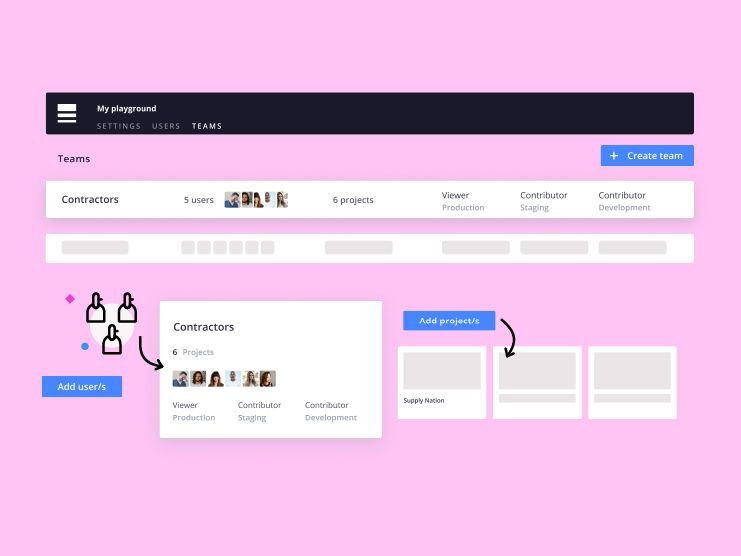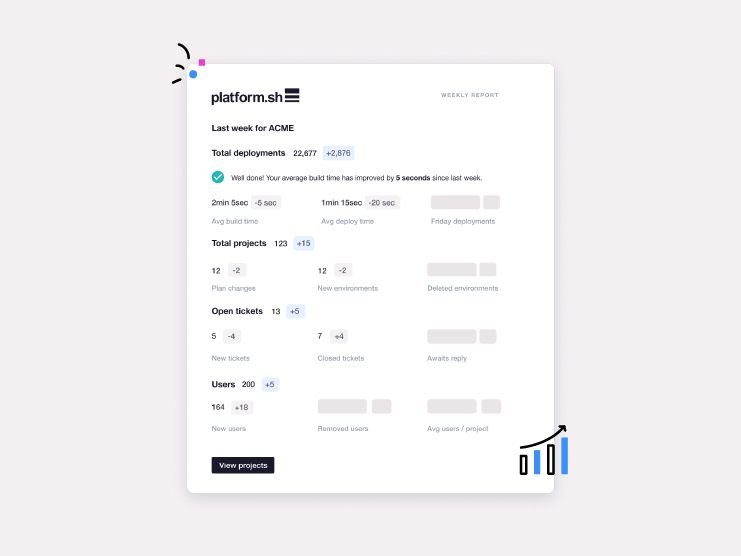
Get more control over your environments with build variables
Pre-release announcement: We’re making the --visible-build flag available as an option for environments.
Environment variables are one of the primary ways to ensure repeatable builds on Platform.sh. They make it possible to reuse a previous build on a new branch, connecting to the current environment's services and other backend resources.
Today we announce that the --visible-build flag, previously only available at the project level, is now an option for environments, letting you tie your environment-specific variables to the build itself.
A new option for making environment variables available during build
Environment-level variables have always been restricted to runtime. If you wanted a variable at build time, you needed to set a project-level variable with the CLI or commit it in your .platform.app.yaml file. In both cases, visibility at build time meant that it was a part of the build image, something that should be considered almost like code. The build image is at its core environment-agnostic, and it can be reused and moved to new environments freely until you change the build process in some way, which gives you a lot of confidence when merging.
But there are times where you want a variable specific to one environment, such as distinguishing whether a Node.js server should run in production or development, available at build time. For this reason, we've enabled the --visible-build flag for variable creation at the environment level. If we continue with the Node.js example, we can consider the following commands:
$ platform variable:create -l environment -e main --prefix env: --name NODE_ENV --value production --visible-build true --inheritable false
$ platform variable:create -l environment -e staging --prefix env: --name NODE_ENV --value development --visible-build true --inheritable trueIn the first command, we’ve set NODE_ENV to production for the default branch, which makes sense for our production application. In the second command, however, the variable is set to development for the staging environment, and it will be inherited into each development environment that branches from it. This can be useful for running a much larger test suite than you would run in production on each development environment, for enabling incremental builds with your decoupled applications, or for providing write access at runtime for a backend headless CMS like Strapi (where it's forbidden in production).
What’s changed
Introducing the --visible-build flag to environment-level variables is just one part of this release. There is another potentially breaking change that you should keep in mind going forward. In the past, if you wanted to trigger a rebuild on your app, you could simply add a small change, even a white space change, to your .platform.app.yaml file.
With this release, this is no longer the case. The .platform.app.yaml file itself is not a part of the build slug reused across environments, nor is it available at all during builds. Instead, it’s only a subset of the values included in that file—those attributes relevant to builds rather than runtime—that are tied to the slug.
For example, changing the version of Node.js your app uses will cause a full rebuild, whereas modifying the post_deploy hook will not. Runtime keys that will no longer trigger rebuilds (but still trigger redeploys) when updated include:
- everything under
resources sizedisk- everything under
access - everything under
relationships - everything under
firewall hooks.deployandhooks.post_deploy- everything under
webexceptweb.mounts - everything under
workersexceptworkers.X.mounts - everything under
crons
While the .platform.app.yaml file isn’t available at build time anymore, you can still retrieve that information from the PLATFORM_APPLICATION environment variable. But it will only include those attributes included in the build slug, and none of those listed above (that is, until deploy time).
(The .platform.app.yaml file not being available during build means that it is not part of the tree of the application, which also influences how the PLATFORM_TREE_ID variable is generated. If you compute this value yourself somewhere—we never documented it, so you know who you are—you will now need to exclude the .platform.app.yaml. This should otherwise not be of concern for most people.)
You can read about these changes in more detail in our updated variables documentation.
An example: Using build environment variables to trigger a rebuild through a source operation
Build environment variables can change a lot of things for your apps. These variables now can become a part of the build image, the same as project variables. This option opens up some interesting possibilities for fleets by creating a kind of platform rebuild command if set up right.
In a previous article, I described a few options for maintaining a content delivery fleet on Platform.sh. The example I used was a Drupal content store, decoupled from any number of frontend Gatsby presentation apps, that would consume and present content across afleet. Thee apps could customize how the content was presented—such as whether it was displayed on a mobile, desktop, gaming, or any other device—and then get triggered from the backend regularly via cron or automatically using a custom Drupal module to rebuild themselves using new content.
Build environment variables provide another method for triggering a rebuild through a source operation. The Drupal store example used a dummy commit to a file in the repository root using the current date:
source:
operations:
update:
command: |
echo Last Content Update: $(date) > counter.txt
echo "Create dummy commit to force rebuild for updated content."
git commit -am "Source Operation: Updated content from backend."If instead we create a FRONTEND_REBUILD_COUNTER variable for our presentation app:
$ platform variable:create -l environment -e main --prefix env: --name FRONTEND_REBUILD_COUNTER --value 1` --visible-build true --inheritable falseWe can redefine the source operation to increment the environment variable instead:
source:
operations:
update:
command: |
platform variable:update FRONTEND_REBUILD_COUNTER $((FRONTEND_REBUILD_COUNTER+1))Build variables are a part of the build slug, so simply updating their value will trigger a rebuild of, in this case, the frontend Gatsby app with the latest content.
No doubt you have many ideas for additional places where the --visible-build flag will be useful. Feel free to share them with us on our community site.
 Switching to Platform.sh can help IT/DevOps organizations drive 219% ROI
Switching to Platform.sh can help IT/DevOps organizations drive 219% ROI Organizations, the ultimate way to manage your users and projects
Organizations, the ultimate way to manage your users and projects



